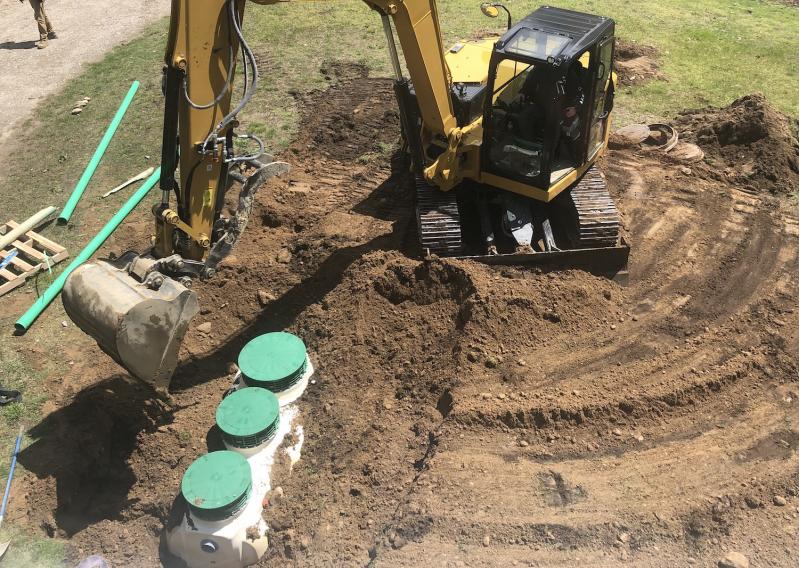Gov. Kathy Hochul signed legislation at Suffolk Community College in Brentwood last week aimed at making septic system upgrades more affordable, which environmental advocates say is critical to addressing impaired water bodies, including in East Hampton Town.
Outdated or failing septic systems are a significant contributor to nutrient pollution, fueling the harmful algal blooms that foul waterways, often closing them to bathing and to the harvesting of shellfish and finfish. Under the new law, which the governor signed on July 23, eligible property owners can be reimbursed for up to 75 percent of eligible costs, up to $25,000, for the installation of an enhanced septic system, or up to $10,000 for the installation of a conventional system.
The governor also announced a $30 million investment for the latest round of the state’s Septic System Replacement Fund Program targeting priority areas, including Long Island, that rely on sole-source aquifers. Under the program, the state will provide money to counties to reimburse eligible property owners for a portion of the cost of replacing cesspools and septic systems and installing more effective systems such as the innovative/alternative systems that significantly reduce nitrogen and also help to mitigate impacts of phosphorus and perfluoroalkyl and polyfluoroalkyl substances, known as PFAS.
“Access to clean water is a basic right, and communities from Montauk to Buffalo deserve safe, reliable water infrastructure,” the governor said at the signing. “Long Island’s water resources are vital to the people who live there, to the local economy, and to the plants and animals that call the Island home.” To that end, two-thirds of the money announced on July 23, or $20 million, will support projects in Suffolk County.
The state’s commitment is the latest component of its clean water infrastructure initiative launched in 2017, a rebate program established to incentivize residential property owners and small businesses to replace and upgrade aging septic systems and eliminate cesspools. The increased state commitment signed into law last week, coupled with voters’ approval last year of the Suffolk County Water Quality Restoration Act, which created an additional one-eighth-percent sales tax dedicated to providing grants for homeowners to replace aging septic systems and expanding public sewers, and East Hampton Town’s existing septic-replacement incentive program, position the town to finally see tangible results in water quality improvement, said Kevin McDonald, the Nature Conservancy’s Long Island policy adviser.
“It is the moment where the state funding, town funding, and county funding is all authorized and now available to take what had been a startup program that began in 2017 and now is ready to be ramped up, a comprehensive water quality restoration initiative,” Mr. McDonald said.
There are 17,000 to 19,000 septic systems in the town, according to Mr. McDonald. “I’m not saying this is easy,” he said, but “the moonshot for the Town of East Hampton is to try to get changed out 1,000 systems per year. Roughly speaking, you could have this completely done in under 20 years, probably sooner. If the town decided to do that as a moonshot change, we could see water quality improvements in under a decade.”
“We appreciate everything all the towns have done so far,” he said, “but now we’re finally at a place where integrating state, county, and town programs to take it to the next level and scale it up, much higher than it is, should be the next goal.”
In the town, around 644 septic system upgrades have happened as a result of an incentive program, not including new construction or major renovations, he said. “Part of that is attributed to a really keen awareness that East Hampton residents have about how important water quality is to their sense of their community.”
That awareness is evident at Concerned Citizens of Montauk, which partners with the Surfrider Foundation’s Blue Water Task Force and Stony Brook University in weekly testing, in the summer months, of more than 30 water bodies for enterococcus and harmful algal blooms. The Blue Water Task Force’s interactive map, at bwtf.surfrider.org, provides site-specific data that can be viewed in the context of the last 30 or 60 days, the previous year, and even back to 2013.
Recently, Surfrider, C.C.O.M., and Peconic Baykeeper have partnered to install signs at beaches that link, via QR code, to the Blue Water Task Force website, allowing the public to make informed decisions about bathing at a particular beach based on the latest snapshot of bacteria levels.
The need for all-inclusive remediation — actions in addition to septic system replacement, C.C.O.M. officials emphasized this week — is acute. The group’s testing conducted last week revealed that 44 percent of its sampled sites had high levels of enterococcus, defined as greater than 104 colony forming units, or C.F.U., per 100 milliliters for marine water and 61 C.F.U./100 ml for fresh water. Two sample sites in Montauk’s Fort Pond, the Benson Drive culvert near Lake Montauk, both sample sites at Northwest Creek, and three of four sites in Accabonac Harbor remained at unsafe, elevated levels.
“C.C.O.M., Surfrider, and others document that there’s a problem,” Mr. McDonald said. “What’s more important to the public is, what can they do? Places like Fort Pond and Ditch Plain, southern Lake Montauk in particular, and in Springs and near Accabonac Harbor, these areas are all hotspots for high nutrient loading from on-site waste disposal systems. We also know they can contribute, especially when they’re old and not working well and failing, to other types of water quality issues, some of which can come up in sampling C.C.O.M. and Surfrider are doing.”
“Septic replacement and upgrades are a no-brainer, but it’s not just that,” Jessica James, president of C.C.O.M.’s board, said this week. Water usage is another. “You can contain water to your property — that is to say, use the water that you need in an appropriate fashion and not overwater. How many times have we driven by and seen, in a rainstorm, the automatic sprinklers going on people’s lawns, and also people overwatering to the point where it’s running down the street? That is something that is so easy to fix and to manage. We know that water pulls anything from the road, or from properties, that we don’t want to go into the water supply. I don’t think we pay enough attention to water management.”
Brody Eggert of Surfrider Foundation’s Eastern Long Island chapter pointed to the two bioswales that filter water as it flows toward the ocean in East Hampton Village. “Those have done wonders in terms of reducing the amount of bacteria we’re seeing” at their terminus, he said. “Something that everybody can do is intentionally use native plants in their backyards to help reduce runoff into these streams and into the ocean. That in itself will help our water quality beyond just bacteria numbers, but our water quality as a whole and our soil quality.”
Use of fertilizer can be modified, said Rebecca Holloway, C.C.O.M.’s manager of environmental advocacy. “If you can switch to organic fertilizer, or not even use fertilizer, that’s a big one.”
C.C.O.M. officials will soon meet with an engineer regarding the Benson Drive culvert, which is not a recreational site but feeds Lake Montauk’s West Creek, which in turn flows to the beach at the end of South Lake Drive, which has long been closed to bathing. Extremely high levels of enterococcus are consistently measured in the weekly sample, with last week’s result more than 24,196 C.F.U./100 ml.
“The logical question is, can some sort of filtration be done to baffle that water before it gets to West Creek?” Ms. James said.
Along with the use of organic fertilizer or none at all, the planting of native vegetation, and upgrading one’s septic system, C.C.O.M.’s Clean Water Steward Pledge includes leaving grass clippings on the lawn, picking up pet waste, even in yards, increasing permeable ground around residences, setting lawn mower height at 3.5 inches or taller, redirecting downspouts into garden beds, using a commercial carwash instead of washing vehicles at home, and adding a rain barrel to one’s yard or garden. C.C.O.M.’s survey listing its pledge is at bit.ly/3GZlLyD.
“We do have a number of actions,” Ms. Holloway said, “that homeowners and residents really can do now to improve water quality even before we have the answers” as to the specific sources of bacterial contamination. More than just septic-system replacement, she said, “we need everything at once.”




